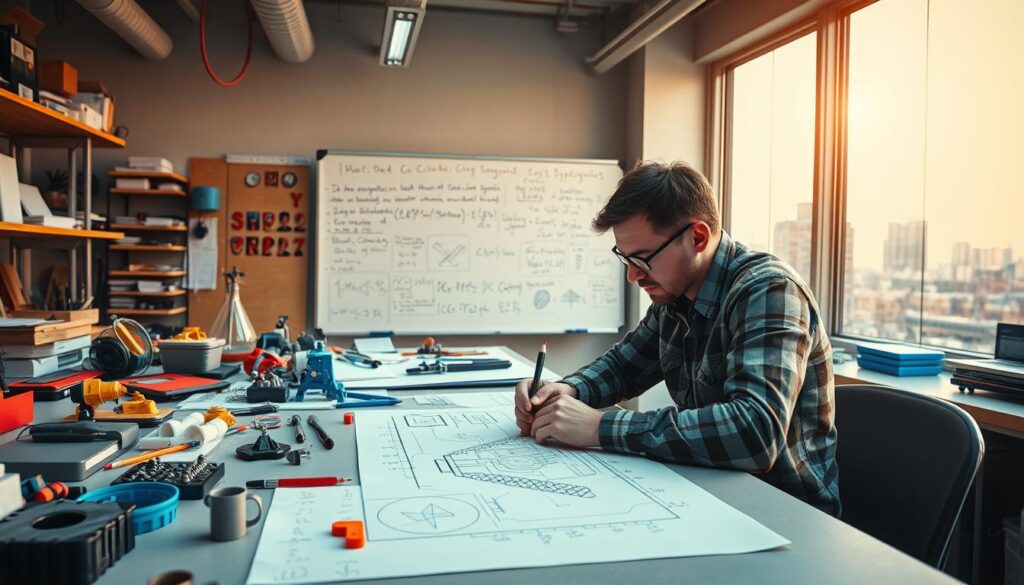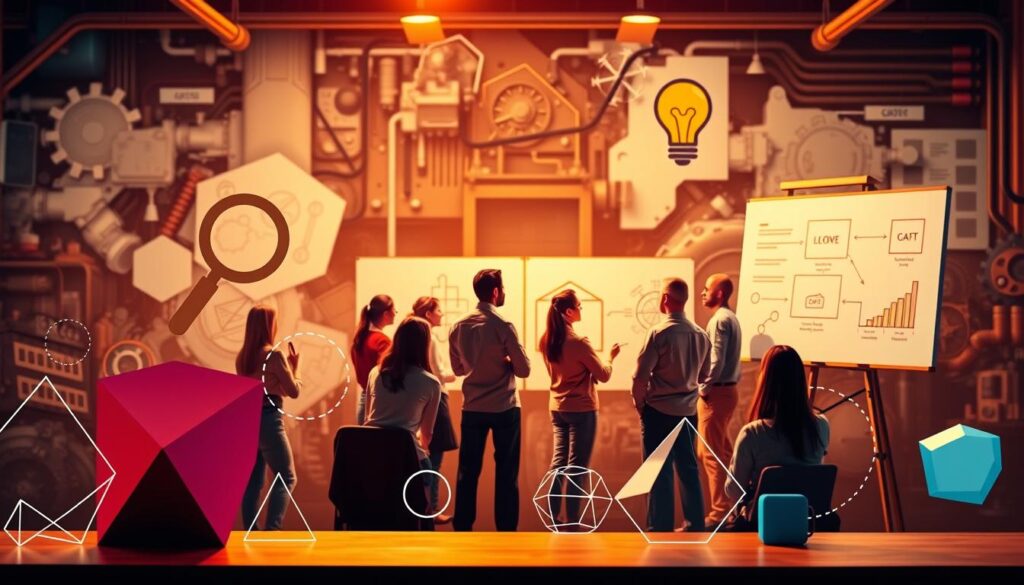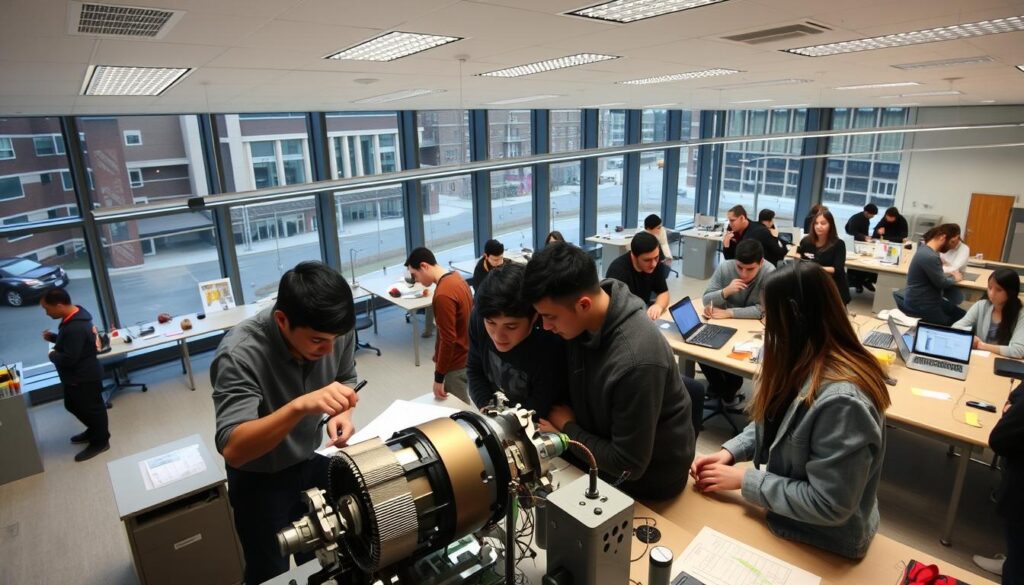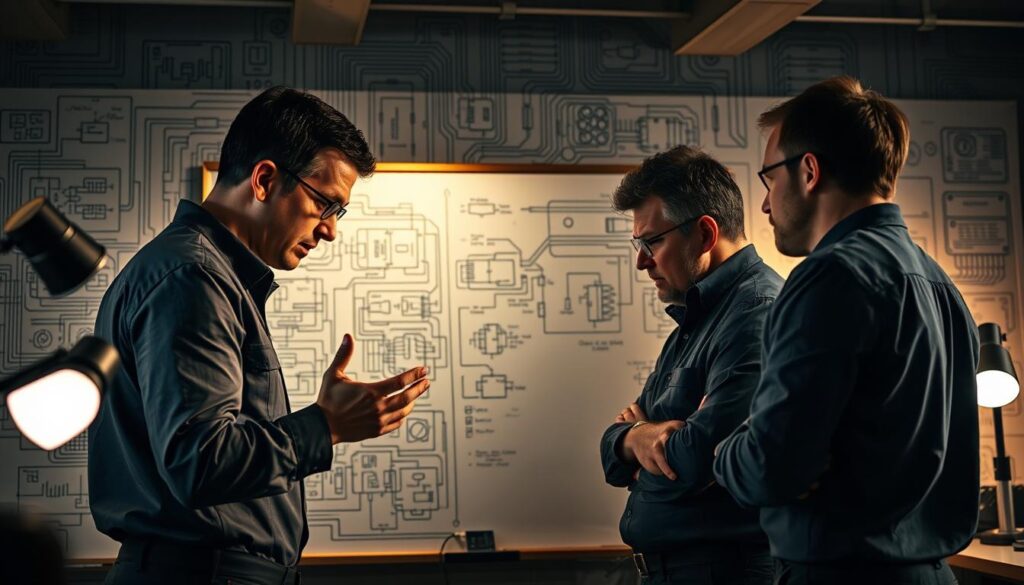In today’s complex world, effective problem-solving strategies are crucial for overcoming the intricate challenges faced by industries.
Did you know that a significant portion of product development time is spent on troubleshooting and resolving technical issues? This not only delays innovation but also increases costs.
Efficient engineering problem solving is key to driving engineering innovation and staying competitive.
Key Takeaways
- Effective problem-solving strategies are essential for industries.
- Troubleshooting is a significant part of product development.
- Efficient problem solving drives innovation.
- Technical problem solving is crucial for competitiveness.
- Problem-solving strategies can reduce costs and delays.
Understanding Engineering Problem Solving
Engineering problem solving encompasses a range of methodologies and tools to address technical issues. It is a critical skill for engineers, enabling them to design, develop, and optimize solutions to complex problems.
Definition and Importance
Engineering problem solving is defined as the process of identifying, analyzing, and solving problems in a systematic and efficient manner. It involves applying technical knowledge, mathematical skills, and scientific principles to develop practical solutions. The importance of engineering problem solving lies in its ability to drive innovation, improve product performance, and reduce costs.
Effective problem-solving techniques are essential in engineering, as they enable engineers to tackle complex challenges and develop creative solutions. According to engineering problem-solving resources, a structured approach is crucial for successful problem solving.
Key Components
The key components of engineering problem solving include:
- Defining the problem: Clearly articulating the issue to be addressed.
- Gathering information: Collecting relevant data and knowledge to understand the problem.
- Analyzing the problem: Breaking down the problem into manageable parts and identifying key factors.
- Generating solutions: Developing potential solutions through creative thinking and technical expertise.
- Evaluating solutions: Assessing the feasibility and effectiveness of proposed solutions.
Methodologies like TRIZ, which emphasizes understanding patterns behind successful ideas, are valuable tools in engineering problem solving. By applying these components, engineers can develop effective solutions to complex problems.
Common Challenges
Despite the importance of engineering problem solving, engineers often face several challenges, including:
- Limited data or information, making it difficult to analyze the problem.
- Complexity of the problem, requiring a multidisciplinary approach.
- Time and budget constraints, which can limit the scope of potential solutions.
To overcome these challenges, engineers must employ critical thinking techniques and creative problem-solving methods. By doing so, they can develop innovative solutions that meet project requirements and stakeholder expectations.
The Engineering Problem-Solving Process

The engineering problem-solving process is a systematic approach to identifying and resolving complex engineering challenges. This process is crucial for developing effective engineering solutions that meet specific needs and requirements.
Effective problem solving in engineering involves several key stages. Understanding these stages is essential for applying problem-solving strategies efficiently.
Identifying the Problem
The first step in the engineering problem-solving process is to clearly identify the problem. This involves defining the issue, understanding the constraints, and determining the objectives. Accurate problem identification is critical for developing relevant solutions.
Engineers often use tools and techniques such as root cause analysis to identify the underlying causes of a problem. This helps in formulating a precise problem statement that guides the subsequent stages of the problem-solving process.
Gathering Information
Once the problem is identified, the next step is to gather relevant information. This may involve collecting data, conducting experiments, or researching existing solutions. The goal is to gain a comprehensive understanding of the problem and its context.
Engineering design thinking emphasizes the importance of empathy and understanding the needs of stakeholders. By gathering information from various sources, engineers can develop a well-rounded perspective on the problem.
Generating Solutions
With a thorough understanding of the problem, the next stage involves generating potential solutions. Techniques such as brainstorming, mind mapping, and the TRIZ approach are commonly used to foster creativity and innovation.
The TRIZ approach, in particular, involves a step-by-step process for problem-solving, including identifying contradictions and leveraging inventive principles. This method encourages engineers to think outside the box and develop novel solutions.
Implementing Solutions
The final stage is implementing the chosen solution. This involves developing a detailed plan, allocating resources, and executing the plan. Monitoring and evaluating the solution’s effectiveness are also crucial to ensure that it meets the desired objectives.
Effective implementation requires careful planning and coordination. Engineers must consider factors such as feasibility, cost, and potential risks when putting their solutions into practice.
Types of Engineering Problems
Understanding the different types of engineering problems is crucial for effective solution implementation. Engineers often face a myriad of challenges that can be broadly categorized into technical issues, design challenges, and process inefficiencies.
Technical Issues
Technical issues are a common type of engineering problem that involves complex technical problem solving. These issues often require a deep understanding of engineering principles and the application of technical problem-solving techniques. Examples include equipment failures, software bugs, and structural damages.
Design Challenges
Design challenges represent another significant category of engineering problems. These challenges involve creating innovative solutions that meet specific criteria and constraints. Effective engineering analysis is critical in addressing design challenges, which may include optimizing system performance, improving product design, or developing new materials.
Process Inefficiencies
Process inefficiencies refer to problems that arise from suboptimal processes or workflows within engineering projects. Identifying and addressing these inefficiencies is vital for improving productivity and reducing costs. Techniques such as process analysis and lean management can be employed to tackle these challenges.
| Type of Problem | Description | Common Solutions |
|---|---|---|
| Technical Issues | Complex technical problems requiring deep engineering knowledge | Troubleshooting, repair, and replacement |
| Design Challenges | Innovative design problems with specific criteria and constraints | Prototyping, simulation, and iterative design |
| Process Inefficiencies | Suboptimal processes or workflows | Process analysis, lean management, and workflow optimization |
Strategies for Effective Problem Solving

Engineering problem solving is most effective when it involves a systematic approach, incorporating critical thinking, creative methods, and analytical tools. This comprehensive strategy enables engineers to tackle complex challenges efficiently.
Critical Thinking Techniques
Critical thinking is a fundamental skill in engineering problem solving, allowing professionals to analyze situations, identify key issues, and develop well-reasoned solutions. Techniques such as root cause analysis and SWOT analysis are invaluable in this process. By applying these methods, engineers can ensure that their solutions address the underlying problems rather than just the symptoms.
For more information on problem-solving methods, you can visit this resource, which provides insights into various strategies used in the field.
Creative Problem-Solving Methods
Creativity plays a crucial role in engineering innovation, enabling the development of novel solutions to complex problems. Techniques like TRIZ (Theory of Inventive Problem Solving) and brainstorming sessions can stimulate creative thinking. These methods encourage engineers to think outside the box and explore unconventional solutions.
Analytical Tools
Analytical tools are essential for evaluating and refining solutions in engineering problem solving. Tools such as simulation software and data analysis programs allow engineers to model different scenarios, predict outcomes, and make informed decisions. By leveraging these tools, engineers can optimize their solutions and ensure they meet the required specifications.
The effective use of these strategies and tools not only enhances problem-solving skills but also drives engineering innovation. By adopting a systematic approach to problem solving, engineers can develop efficient, creative, and practical solutions to the challenges they face.
The Role of Collaboration in Engineering
Effective collaboration is crucial in engineering, where diverse expertise and perspectives come together to drive project success. In the complex world of engineering, no single individual can possess all the knowledge required to solve multifaceted problems. Therefore, collaboration becomes the cornerstone of engineering solutions, enabling teams to pool their collective expertise.
Benefits of Teamwork
Teamwork in engineering offers numerous benefits, including improved communication, increased innovation, and better problem-solving capabilities. When engineers work together, they can share their knowledge and experiences, leading to more effective problem-solving techniques. Some key advantages of teamwork include:
- Enhanced creativity through diverse perspectives
- Improved decision-making through collective input
- Better resource allocation and task distribution
- Increased motivation and accountability among team members
Communication Techniques
Effective communication is the backbone of successful collaboration in engineering. Teams that communicate effectively can avoid misunderstandings, reduce errors, and ensure that all members are aligned with the project goals. Some effective communication techniques include:
- Regular team meetings to discuss progress and challenges
- Clear and concise documentation of project plans and decisions
- Active listening to ensure all voices are heard
For more insights on collaborative problem-solving in engineering, visit University of Sioux Falls Online.
Leveraging Diverse Perspectives
Diversity in engineering teams brings together individuals with different backgrounds, experiences, and expertise. This diversity is a powerful catalyst for innovation, as it introduces a wide range of engineering design thinking approaches. By leveraging these diverse perspectives, teams can develop more comprehensive and creative solutions to complex engineering challenges.
In conclusion, collaboration is a vital component of successful engineering projects. By fostering a culture of teamwork, effective communication, and diverse perspectives, engineering teams can enhance their problem-solving capabilities and drive project success.
Tools and Technologies

In the realm of engineering, problem-solving tools and technologies play a crucial role in driving innovation. The right set of tools can significantly enhance the efficiency and effectiveness of the problem-solving process.
Software Solutions
Software solutions are at the heart of modern engineering analysis. They range from computer-aided design (CAD) software to complex simulation tools that can model real-world conditions. These software solutions enable engineers to design, test, and optimize their solutions in a virtual environment, reducing the need for physical prototypes and speeding up the development process.
Some of the key software solutions include:
- CAD software for designing and drafting
- Finite Element Analysis (FEA) for stress analysis
- Computational Fluid Dynamics (CFD) for fluid flow and heat transfer analysis
Modeling and Simulation Tools
Modeling and simulation tools are essential for understanding complex systems and predicting their behavior under various conditions. These tools allow engineers to create detailed models of their designs and simulate how they will perform in real-world scenarios.
The benefits of using modeling and simulation tools include:
- Reduced costs by minimizing the need for physical prototypes
- Improved product performance through optimized designs
- Enhanced safety by simulating extreme conditions
Data Analysis Tools
Data analysis tools are critical for interpreting the vast amounts of data generated during the engineering problem-solving process. These tools help engineers to identify trends, detect anomalies, and make informed decisions based on data-driven insights.
Some popular data analysis tools used in engineering include:
| Tool | Description | Application |
|---|---|---|
| MATLAB | High-level programming language for numerical computation | Data analysis, simulation, and modeling |
| Python | General-purpose programming language with extensive libraries for data analysis | Data analysis, machine learning, and visualization |
| Excel | Spreadsheet software for data manipulation and analysis | Data analysis, visualization, and reporting |
Case Studies in Engineering Problem Solving
Case studies in engineering problem solving highlight the importance of innovative approaches in overcoming complex challenges. By examining real-world examples, we can gain insights into effective problem-solving strategies and their applications in various engineering contexts.
Success Stories
One notable example of successful engineering problem solving is the application of TRIZ, a methodology that has been used across different industries to solve complex problems. For instance, TRIZ has been employed in the development of new products and processes, leading to significant improvements in efficiency and innovation. A detailed guide on managing civil engineering projects can be found here, which highlights the importance of effective problem solving in project management.
The use of TRIZ and other engineering innovation techniques has enabled companies to overcome seemingly insurmountable challenges, resulting in breakthroughs and competitive advantages. These success stories underscore the value of investing in engineering problem-solving capabilities.
Lessons Learned from Failures
While success stories are inspiring, they are often accompanied by lessons learned from failures. Analyzing failures in engineering problem solving provides valuable insights into what went wrong and how similar issues can be avoided in the future.
For example, a project that failed to meet its objectives due to unforeseen technical issues can offer lessons on the importance of thorough risk assessment and contingency planning. By understanding these lessons, engineers can refine their problem-solving strategies to improve outcomes in future projects.
In conclusion, case studies in engineering problem solving, including both successes and failures, offer invaluable insights into the application of effective problem-solving strategies. By learning from these examples, engineers can enhance their ability to tackle complex challenges and drive engineering innovation.
Applying Systems Thinking

As engineering problems become more complex, systems thinking offers a holistic solution. This approach considers the intricate interactions within a system, enabling engineers to develop more effective solutions.
What is Systems Thinking?
Systems thinking is a methodology that analyzes complex systems by understanding the interactions and interdependencies of their components. It involves looking at the system as a whole, rather than focusing on individual parts in isolation. This approach helps engineers identify the root causes of problems and develop comprehensive solutions.
Key characteristics of systems thinking include:
- Holistic analysis
- Understanding of complex interactions
- Identification of interdependencies
- Focus on the overall system behavior
Benefits in Engineering
The application of systems thinking in engineering offers numerous benefits, including improved problem-solving capabilities and enhanced collaboration among team members. By considering the entire system, engineers can develop more effective and sustainable solutions.
The benefits of systems thinking in engineering are multifaceted:
- Enhanced problem-solving capabilities
- Improved collaboration and communication
- Better understanding of complex systems
- More effective and sustainable solutions
Implementation Strategies
To implement systems thinking effectively, engineers can adopt several strategies. These include developing a deep understanding of the system, using appropriate tools and techniques, and fostering a collaborative environment.
Effective implementation strategies for systems thinking include:
- Developing a comprehensive understanding of the system and its components
- Utilizing tools and techniques such as system mapping and modeling
- Fostering a collaborative and interdisciplinary team environment
- Encouraging continuous learning and adaptation
By applying these strategies, engineers can harness the power of systems thinking to tackle complex problems and develop innovative solutions.
Engaging Stakeholders
In the realm of engineering, engaging stakeholders is essential for achieving project goals. Effective stakeholder engagement is critical in ensuring that engineering projects meet their intended objectives and are completed on time.
Identifying Key Stakeholders
Identifying key stakeholders is the first step in stakeholder engagement. This involves determining who will be impacted by the project or who can influence its outcome. Key stakeholders may include project team members, customers, end-users, sponsors, and regulatory bodies.
To identify key stakeholders, engineers can use various techniques such as stakeholder mapping and analysis. This helps in understanding the stakeholders’ needs, expectations, and levels of influence.
Communicating Effectively
Effective communication is vital in stakeholder engagement. It involves conveying project information in a clear and concise manner to the relevant stakeholders. Engineers can use various communication techniques such as reports, meetings, and presentations to engage stakeholders.
For more insights on effective communication techniques, you can refer to resources such as this LinkedIn article on engaging stakeholders in technical projects.
Managing Expectations
Managing stakeholder expectations is crucial in ensuring that projects are completed successfully. This involves setting clear expectations and ensuring that stakeholders are informed of any changes or issues that may arise during the project.
| Stakeholder Group | Expectations | Communication Strategy |
|---|---|---|
| Project Team Members | Clear project goals and timelines | Regular team meetings and updates |
| Customers/End-users | Meeting their needs and expectations | Surveys, feedback sessions, and product demos |
| Sponsors | Project progress and ROI | Regular progress reports and financial updates |
By effectively identifying key stakeholders, communicating with them, and managing their expectations, engineers can ensure the success of their projects.
The Importance of Documentation

Accurate and comprehensive documentation is essential for engineers to analyze problems, develop solutions, and implement them effectively. In the complex world of engineering, documentation serves as a critical tool for knowledge sharing, collaboration, and problem-solving.
Keeping Accurate Records
Maintaining accurate records is a fundamental aspect of engineering documentation. This involves documenting every stage of the problem-solving process, from initial analysis to final implementation. Accurate records help engineers track progress, identify potential issues, and refine their solutions.
To keep accurate records, engineers should focus on clarity, precision, and comprehensiveness. This includes detailing the methods used for analysis, the data collected, and the reasoning behind the chosen solutions. By doing so, engineers can ensure that their documentation is not only informative but also useful for future reference.
Best Practices for Documentation
Implementing best practices for documentation is crucial for maximizing its benefits. Some key practices include:
- Using clear and concise language
- Organizing information in a logical and accessible manner
- Regularly updating documentation to reflect changes and new information
- Utilizing visual aids such as diagrams and charts to enhance understanding
By adopting these best practices, engineers can enhance the quality and utility of their documentation, thereby improving their problem-solving capabilities and collaboration with others.
Continuous Improvement in Engineering
Embracing continuous improvement allows engineers to refine their problem-solving strategies continually. This approach is fundamental to achieving excellence in engineering by fostering a culture that values ongoing enhancement and innovation.
The Concept of Kaizen
At the heart of continuous improvement is the Japanese philosophy of Kaizen, which emphasizes the importance of making small, incremental changes to improve efficiency and productivity. In engineering, Kaizen encourages a proactive approach to identifying areas for improvement and implementing solutions.
By adopting Kaizen principles, engineering teams can cultivate a mindset that seeks out opportunities for growth and development, leading to enhanced engineering innovation.
Measuring Success
To ensure the effectiveness of continuous improvement initiatives, it’s crucial to measure their success. This involves setting clear goals and benchmarks, tracking progress, and analyzing outcomes. Key performance indicators (KPIs) such as project completion times, defect rates, and customer satisfaction can provide valuable insights into the impact of improvement efforts.
Regular assessment and feedback enable teams to adjust their strategies, making data-driven decisions to optimize their problem-solving strategies.
Feedback Loops
An essential component of continuous improvement is the establishment of feedback loops. These loops facilitate the flow of information between different stages of a project or process, allowing for real-time adjustments and improvements. By incorporating feedback from stakeholders, including customers and team members, engineers can identify areas for enhancement and implement changes effectively.
Effective feedback loops help in sustaining the momentum of continuous improvement, driving ongoing innovation and excellence in engineering practices.
Teaching Problem Solving in Engineering Education

Effective engineering education hinges on cultivating robust problem-solving skills in students. As the field of engineering continues to evolve, it is crucial that educational institutions adapt their curricula to meet the changing demands of the profession.
Problem-solving techniques are at the heart of engineering practice. By integrating these techniques into the curriculum, educators can help students develop a systematic approach to tackling complex problems.
Curriculum Development
Curriculum development plays a critical role in teaching problem-solving skills. Educators should focus on creating a curriculum that balances theoretical foundations with practical applications. This can be achieved by incorporating real-world examples and case studies into the coursework.
For instance, courses on engineering analysis can be designed to include project-based learning, where students work on actual engineering problems. This approach not only enhances their analytical skills but also prepares them for the challenges they will face in their professional careers.
Hands-On Learning Approaches
Hands-on learning is an essential component of engineering education. By engaging in practical problem-solving activities, students can develop a deeper understanding of engineering principles. This can be achieved through laboratory experiments, design projects, and internships.
Moreover, hands-on learning approaches can be used to foster collaboration and teamwork among students. By working together on projects, students can learn from each other’s strengths and weaknesses, developing essential communication and project management skills.
In conclusion, teaching problem-solving skills in engineering education requires a multifaceted approach that includes both curriculum development and hands-on learning. By focusing on these areas, educators can prepare students for success in their future careers.
The Role of Innovation
Innovation plays a crucial role in engineering problem-solving by fostering creative solutions. It enables engineers to approach challenges from unique angles, often leading to breakthroughs that might not have been achieved through conventional methods.
To understand the impact of innovation, let’s first consider how it is encouraged within engineering teams. Creative problem-solving techniques, such as brainstorming and mind mapping, are commonly used to stimulate innovative thinking.
Encouraging Creative Solutions
Encouraging creative solutions involves creating an environment where engineers feel empowered to experiment and propose novel ideas. This can be achieved through:
- Providing resources and time for research and development.
- Fostering a culture that values and rewards creativity.
- Encouraging collaboration among diverse teams to bring different perspectives together.
For more insights on how innovation is applied in engineering, visit Jaktool’s page on problem-solving and innovation in.
Balancing Innovation with Practicality
While innovation is crucial, it’s equally important to balance it with practicality. This means ensuring that new solutions are not only creative but also feasible, cost-effective, and aligned with project goals.
| Aspect | Innovation Focus | Practicality Focus |
|---|---|---|
| Solution Development | Emphasizes creativity and new approaches. | Focuses on feasibility, cost, and efficiency. |
| Implementation | May involve significant changes or new technologies. | Aims for smooth integration with existing systems. |
| Outcome | Often results in novel solutions. | Ensures solutions are viable and meet project constraints. |
By striking the right balance between innovation and practicality, engineers can develop solutions that are both groundbreaking and implementable. This balance is key to successful engineering problem-solving.
Overcoming Resistance to Change

Engineering projects often encounter resistance to change, which can be mitigated through effective strategies and stakeholder engagement. Understanding the root causes of resistance and implementing appropriate countermeasures are crucial for the successful execution of engineering projects.
Understanding Human Factors
Human factors play a significant role in resistance to change. Fear of the unknown, job insecurity, and lack of understanding are common reasons why individuals resist change.
To address these concerns, it’s essential to:
- Communicate the reasons behind the change clearly
- Involve stakeholders in the decision-making process
- Provide training and support to alleviate fears and build confidence
Strategies for Encouragement
Effective change management involves strategies that encourage stakeholders to embrace change.
Key strategies include:
- Developing a clear vision and communicating it effectively
- Engaging stakeholders through regular updates and feedback mechanisms
- Recognizing and rewarding contributions to the change process
Professional Development for Engineers

To stay ahead, engineers need to embrace lifelong learning and professional growth opportunities. This not only enhances their skills but also keeps them updated with the latest technologies and methodologies.
Professional development is crucial for engineers to remain relevant in their field. It encompasses various aspects, including formal education, workshops, conferences, and online courses. Lifelong learning opportunities are vital for engineers to adapt to new challenges and advancements.
Lifelong Learning Opportunities
Engineers can benefit from numerous lifelong learning opportunities. These include:
- Online courses and certifications
- Workshops and conferences
- Mentorship programs
- Professional certifications
By engaging in these activities, engineers can enhance their problem-solving skills and stay updated with industry trends. For more information on professional development opportunities, visit RCEL Connect.
Networking and Mentorship
Networking and mentorship are critical components of professional development. They provide engineers with opportunities to learn from others, share their experiences, and gain insights into best practices.
Effective networking can lead to collaborative opportunities, innovation, and access to new technologies. Mentorship, on the other hand, provides guidance and support, helping engineers navigate their careers and make informed decisions.
The Future of Engineering Problem Solving
The future of engineering is intricately linked with the ability to adapt and evolve in response to emerging challenges. As we move forward, engineers will need to be equipped with effective problem-solving strategies to tackle complex issues.
Trends such as the integration of artificial intelligence, advancements in renewable energy, and the development of smart city technologies will shape the future of engineering. To stay ahead, engineers must be prepared to embrace emerging technologies and leverage them to drive innovation.
Key Trends and Technologies
Some of the key trends to watch include the continued development of sustainable infrastructure, advancements in health informatics, and the need for enhanced cybersecurity measures. Engineers will need to be adept at applying problem-solving strategies to these complex challenges.
By staying informed about the latest developments and being prepared to adapt, engineers can position themselves at the forefront of the field. For more information on the grand challenges facing engineers, visit World Civil Society.
